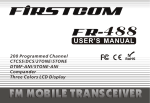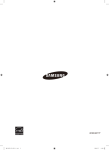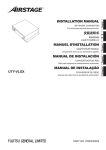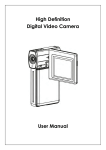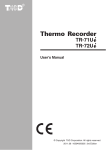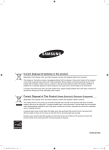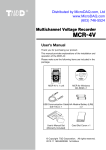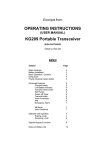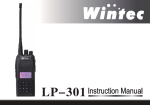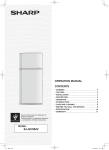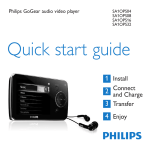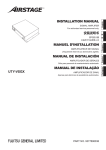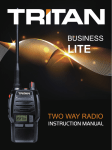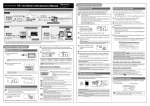Download 8 - pmr446
Transcript
INTRODUCTION Thank you for purchasing Series Radio. The Series radios provide cost effective communications for businesses, they are the perfect communications solution for all of todays fast-paced industries. Please read this guide carefully so you know how to properly operate the radio before use. Motorola Solutions (Shanghai) Co., Ltd. 6F, Building 11, No.1257, Mingyue Road Pudong New District Shanghai 201206, P.R.C. +86 21 50800578 www.smp.com.cn SMP, the stylized logo, and all other trademarks indicated as such herein are trademarks of Motorola Solutions (Shanghai) Co., Ltd. All other product or service names are the property of their respective owners, © 2011 Motorola Solutions (Shanghai) Co., Ltd. Safety and General Information Product Safety and RF Exposure for Mobile Two-Way Radios Installed in Vehicles or as Fixed Site Control Stations BEFORE USING THIS RADIO, READ THIS BOOKLET WHICH CONTAINS IMPORTANT OPERATING INSTRUCTIONS Caution FOR SAFE USAGE AND RF ENERGY AWARENESS AND CONTROL INFORMATION FOR COMPLIANCE WITH RF ENERGY EXPOSURE LIMITS IN APPLICABLE NATIONAL AND INTERNATIONAL STANDARDS. The information provided in this document supersedes the general safety information contained in user guides published before. Compliance and Control Guidelines and Operating Instructions for Mobile Two-Way Radios Installed in Vehicles To control exposure to yourself and others and to ensure compliance with the RF exposure limits, always adhere to the following procedures: Guidelines User awareness instructions should accompany device when transferred to other users. Do not use this device if the operational requirements described herein are not met. Instructions Transmit no more than the rated duty factor of 50% of theTime. To transmit (talk), push the Push-To-Talk (PTT) button or, for radios equipped with VOX, speak into the microphone,The red LED will illuminate when the radio is transmitting. To receive calls, release the PTT button or, for radios equipped with VOX, stop talking. The red LED will extinguish when the radio stops transmitting. Transmitting 50% of the time, or less, is important because this radio generates measurable RF energy exposure only when transmitting. Transmit only when people outside the vehicle are at least the recommended minimum lateral distance away, as shown in Table 1, from the body of a vehicle with a properly installed antenna. This separation distance will ensure that there is sufficient distance from a properly installed (according to installation instructions) externallymounted antenna to satisfy the RF exposure requirements . Table 1 below lists the recommended lateral distance for people in an uncontrolled environment from the body of a vehicle with an approved, properly installed transmitting NOTE antenna (i.e., monopoles over a ground plane, or dipoles) at several different ranges of rated radio power for mobile radios installed in a vehicle. Table 1: Rated Power of Vehicle-Installed Mobile Two-Way Radio and Recommended Minimum Lateral Distance from Vehicle Body. Mobile Radio Rated Power Minimum Lateral Distance from Vehicle Body Less than 7 watts 20 centimeters 7 to 15 watts 30 centimeters 16 to 39 watts 60 centimeters 40 to 110 watts 90 centimeters When a mobile radio is used in conjunction with another co-located transmitter such as a Vehicular Repeater, it is the vehicle operator's responsibility to take appropriate steps to keep bystanders at the required separation distance from the vehicle to ensure compliance with the RF energy exposure limits for the general population. If you are not sure of the rated power of your radio,contact your SMP representative or dealer and supply the radio model NOTE number found on the radio model label. If you cannot determine the rated power out, then assure 90 centimeters separation from the body of the vehicle. Mobile Antenna Installation Guidelines These mobile antenna installation guidelines are limited to metal body motor vehicles or vehicles with appropriate ground planes. Antennas should be installed in the center area of the roof or the trunk lid taking into account the exposure conditions of backseat passengers and according to the specific instructions and restrictions in the Radio Installation Manual along with the requirements of the antenna supplier. Trunk lid installations are limited to vehicles with clearly defined flat trunk lids, and in some cases, to specific radio models and antennas. Approved Accessories Use only the SMP-approved, supplied accessory or a SMP-approved replacement accessory. Unauthorized accessories, modifications, or attachments could damage the radio and may result in non-compliance with RF Safety Standards. For a list of SMP-approved accessories, visit the following web site, which lists approved accessories for your radio model: http://www.smp. com.cn Compliance and Control Guidelines and Operating Instructions for Mobile Two-Way Radios Installed as Fixed Site Control Stations If mobile radio equipment is installed at a fixed location and operated as a control station or as a fixed unit, the antenna installation must comply with the requirements in order to ensure optimal performance and compliance with the RF energy exposure limits. The antenna should be mounted outside the building on the roof or a tower if at all possible. As with all fixed site antenna installations, it is the responsibility of the licensee to manage the site in accordance with applicable regulatory requirements and may require additional compliance actions such as site survey measurements, signage, and site access restrictions in order to ensure that exposure limits are not exceeded. For additional installation information, see the guidelines for minimum separation distances provided above in the Compliance and Control Guidelines and Operating Instructions for Mobile TwoWay Radios Installed in Vehicles. Electromagnetic Interference/Compatibility Nearly every electronic device is susceptible to electromagnetic interference (EMI) if inadequately shielded, designed, or otherwise configured for electromagnetic compatibility. It may be necessary to conduct compatibility testing to determine if NOTE any electronic equipment used in or around vehicles or near fixed site antenna is sensitive to external RF energy or if any procedures need to be followed to eliminate or mitigate the potential for interaction between the radio transmitter and the equipment or device. Facilities To avoid electromagnetic interference and/or compatibility conflicts, turn off your radio in any facility where posted notices instruct you to do so. Hospitals or health care facilities may be using equipment that is sensitive to external RF energy. Vehicles To avoid possible interaction between the radio transmitter and any vehicle electronic control modules, such as ABS, engine, or transmission controls, the radio should be installed only by an experienced installer and the following precautions should be used when installing the radio: 111Refer to the manufacturer's instructions or other technical bulletins for recommendations on radio installation. 222Before installing the radio, determine the location of the electronic control modules and their harnesses in the vehicle. 333Route all radio wiring, including the antenna transmission line, as far away as possible from the electronic control units and associated wiring. Driver Safety Check the laws and regulations on the use of radios in the area where you drive. Always obey them. When using your radio while driving, please: Give full attention to driving and to the road. Pull off the road and park before making or answering a call if driving conditions so require. Operational Warnings For Vehicles With An Air Bag Do not mount or place a mobile radio in the area over an air bag or in the air bag deployment area. Air bags inflate with great force. If a radio is placed in the air bag deployment area and the air bag inflates, the radio may be propelled with great force and cause serious injury to occupants of the vehicle. Potentially Explosive Atmospheres Turn off your radio prior to entering any area with a potentially explosive atmosphere. Sparks in a potentially explosive atmosphere can cause an explosion or fire resulting in bodily injury or even death. The areas with potentially explosive atmospheres include fueling areas such as below decks on boats, fuel or chemical transfer or storage facilities, and areas where, the air contains chemicals or particles such as grain, dust or metal powders. Areas with potentially explosive atmospheres are often, but not always posted. Blasting Caps and Blasting Areas To avoid possible interference with blasting operations, turn off your radio when you are near electrical blasting caps, in a blasting area, or in areas posted: "Turn off two-way radio”. Obey all signs and instructions. For radios installed in vehicles fueled by liquefied petroleum gas, refer to the local standard for storage, handling, and/or container information. CONTENTS Features and Precautions....................................................1 Transmitting Optional Signaling ....................................................... 13 Supplied Accessories/Optional Accessories......................2 Channel Edit..................................................................................... 13 Supplied Accessories........................................................................ 2 Channel Delete................................................................................. 13 Optional Accessories........................................................................ 2 Shortcut Operations..............................................................14 Initial Installation...................................................................3 Squelch Off/Squelch Off Momentary................................................ 14 Mobile Installation............................................................................. 3 DC Power Cable Connection............................................................ 4 Squelch Level Setup......................................................................... 14 Frequency/Channel Scan................................................................. 14 Power Supply Voltage Display.......................................................... 6 Channel Scan................................................................................... 14 Antenna Connection......................................................................... 6 CTCSS/DCS Encode and Decode Setup......................................... 14 Accessories Connections.................................................................. 7 CTCSS Scan..................................................................................... 15 Getting Acquainted...............................................................8 DCS Scan......................................................................................... 15 Front panel........................................................................................ 8 High/Mid/Low Power Switch............................................................. 15 Rear panel........................................................................................ 9 Compander (Decrease the background noise and enhance audio clarity...................................................................................................15 Display.............................................................................................. 9 Microphone....................................................................................... 10 Offset Direction and Offset Frequency Setup................................... 16 Working Mode(Amateur Transceiver or Professional Transceiver) ........................................................................11 Current Voltage Enquiry.................................................................... 16 Basic Operations ..................................................................12 Switching the Power On/Off . ........................................................... 12 Adjusting the Volume ....................................................................... 12 Switch between VFO and Channel mode ........................................ 12 Adjusting Frequency/Channel Through Selector Knob..................... 12 Receiving.......................................................................................... 12 Transmitting...................................................................................... 12 Transmitting Tone-Pulse................................................................... 13 Keypad Lockout................................................................................ 16 Auto-Dialer Setup.............................................................................. 16 Transmitting Edited DTMF Tones in the Auto-dialer Memory............ 17 General Setting......................................................................18 01 Frequency Channel Step Setup................................................... 18 02 DTMF, DTMF ANI, 2Tone or 5Tone Signaling.............................. 18 03 Sending 2-Tone Call..................................................................... 19 04 Sending 5-Tone Call..................................................................... 19 05 Sending DTMF call...................................................................... 19 06 Signaling Combination Setup....................................................... 19 CONTENTS 07 HIGH/MID/LOW Power Selection................................................ 20 Squelch Level................................................................................... 27 08 Band-width Selection................................................................... 20 Optional Signaling . .......................................................................... 27 09 TX OFF Setup.............................................................................. 21 Scan Skip . ....................................................................................... 28 10 Busy Channel Lockout................................................................. 21 Frequency/Channel Scan ................................................................ 28 11 Editing Channel Name................................................................. 21 Busy Channel Lockout...................................................................... 28 12 Reverse TX/RX............................................................................ 21 Reverse TX/RX................................................................................. 28 13 Talk Around.................................................................................. 22 TOT (Time-out timer)......................................................................... 29 14 Voice Compander ....................................................................... 22 CTCSS/DCS Encode and Decode.................................................... 29 15 Scrambler Setup (Encryption)...................................................... 22 Talk Around ...................................................................................... 29 16 Radio's DTMF SELF ID ENQUIRY ............................................. 22 Beep Tone......................................................................................... 29 17 Radio's 5TONE SELF ID ENQUIRY ........................................... 23 HIGH/MID/LOW Power Selection..................................................... 29 18 Voice Prompt................................................................................ 23 LCD Backlight .................................................................................. 30 19 TOT (Time-out timer)................................................................... 23 Cable Clone . .........................................................................31 20 APO (Auto power off)................................................................... 23 21 DTMF Transmitting Time.............................................................. 24 Programming Software Installing and Starting (in windows XP system).............................................................................32 22 Squelch Level Setup.................................................................... 24 Maintenance...........................................................................33 23 Scan Dwell Time Setup................................................................ 24 Default Setting after Resetting(VHF)................................................ 33 24 LCD Backlight.............................................................................. 24 Default Setting after Resetting(UHF)................................................ 33 25 Pilot Frequency............................................................................ 25 Default Setting after Resetting(UHF)................................................ 33 26 Display Mode Setup..................................................................... 25 Trouble Shooting............................................................................... 33 27 PIN Setup ................................................................................... 25 Specifications........................................................................34 28 Address List ................................................................................ 26 29 Factory Default............................................................................. 26 Microphone Operation..........................................................27 Function Setup By Microphone Keypad............................................ 27 Appendix................................................................................35 50 groups CTCSS Tone Frequency(Hz)........................................... 35 1024 groups DCS Code.................................................................... 35 1 Features and Precautions Features Display on a large LCD with adjustable brightness, convenient for usage in different environments. There are Amateur operation mode and Professional operation mode to preset. 200 programmable memorized channels, identified by editing name. When programming the transceiver, please firstly read the factory initial data, then change frequency,signalling and etc. Otherwise errors may occur because of improper frequency band and etc. Fitted software: SMP908 Please observe the following precautions to prevent fire, personal injury, or transceiver damage: Programming different CTCSS, DCS, 2Tone, 5Tone in per channel, This transceiver is designed for a 13.8V DC power supply. Don't use a 24V battery to power on the transceiver. Various scan functions including CTCSS/DCS Scan function. Do not place the transceiver in excessively dusty, humid or wet areas, nor unstable surfaces. rejecting extra calling from other radios. Using 5Tone to send Message, Emergency alarm, Call all, ANI, Remotely kill, Remotely Waken, etc. Automatic calling Identification function by DTMF--ANI or 5Tone-ANI . 1 Precautions Optional scramble function to increase confidentiality (Customer optional). Compander function for decrease the background noise and enhance audio clarity, it can set compander ON/OFF per channel. Different band width per channel, 25K for wide band, 20K for middle band ,or 12.5K for narrow band. Customizable password on boot and programming to protect user privacy and information safety. Please keep it away from interferential devices (such as TV, generator etc.) Do not expose the transceiver to long periods of direct sunlight nor place it close to heating appliances. If an abnormal odor or smoke is detected coming from the transceiver, turn OFF the power immediately. Contact an Anytone service station or your dealer. Do not transmit with high output power for extended periods; the transceiver may overheat. Supplied Accessories/Optional Accessories 2 Supplied Accessories After carefully unpacking the transceiver, identify the items listed in the table below. We suggest you keep the box and packaging. SMP908 Transceiver Microphone DTMF with keyboard[50Q182901] Spare Fuses (one pair) [92Q183201] Mobile Mounting Bracket [10Q183001] DC Cable & Fuse Socke [25Q183101] Hardware Kit for Bracket [01Q183501] Black screws 4PCS(M4X8mm) Tapping screws 4PCS(M5X8mm) User Manual in Chinese/ English 2 Optional Accessories Cloning Cable [30Q183601] External Speaker S-Washer USB Programming Cable [30Q183301] Desktop Microphone Cigar-Plug Connection Line [30Q183401] Regulated Power Supply Car Antenna Note: All item number may change due to version upgrading. The availability of the accesories may be different for specified sales territory. For more information on new items, pls check the SMP website: http://www.smp.com.cn 3 Initial Installation Mobile installation To install the transceiver, select a safe, convenient location inside your vehicle that minimizes danger to your passengers and yourself while the vehicle is in motion. Consider installing the unit at an appropriate position so that knees or legs will not strike it during sudden braking of your vehicle. Try to pick a well ventilated location that is shielded from direct sunlight. Meanwhile, please keep the location away from an air bag and its work area. 111Install the mounting bracket in the vehicle using the supplied selftapping screws (4pcs) and flat washers (4pcs). Car body Washer (M5) Tapping screw (M5x20mm) 3 Mounting bracket 222Position the transceiver, then insert and tighten the supplied hexagon SEMS screws. Double check that all screws are tightened to prevent vehicle vibration from loosening the bracket or transceiver. Determine the appropriate angle of the transceiver, using the 3 screw hole positions on the side of the mounting bracket. Initial Installation DC Power Cable Connection 3 Red Locate the power input connector as close to the transceiver as possible. Mobile Operation The vehicle battery must have a nominal rating of 12V. Never connect the transceiver to a 24V battery. Be sure to use a 12V vehicle battery that has sufficient current capacity. If the current to the transceiver is insufficient, the display may darken during transmission, or transmitting output power may drop excessively. Black 666Connect the DC power cable to the transceiver's power supply connector. Press the connectors firmly together until the locking tab clicks. 111Route the DC power cable supplied with the transceiver directly to the vehicle's battery terminals using the shortest path from the transceiver. Please do not use the cigarette lighter socket as some cigarette lighter sockets introduce an unacceptable voltage drop or low current supply. 4 The entire length of the cable must be dressed so it is isolated from heat, moisture, and the engine secondary (high voltage) ignition system/ cables. 222After installing cable, in order to avoid the risk of damp, please use heat-resistant tap to tie together with fuse box. Don't forget to reinforce whole cable. 333In order to avoid the risk of short circuit, please cut down connection with negative (-) of battery, then connect with radio. 444Confirm the correct polarity of the connections, then attach the power cable to the battery terminals; red connects to the positive (+) terminal and black connects to the negative (-) terminal. Use the full length of the cable without cutting off excess even if the cable is longer than required. In particular, never remove the fuse holders from the cable. 555Reconnect any wiring removed from the negative terminal. DC power cable Ext. Power jack If the ignition-key on/off feature is desired(optional feature),use the optional QCC-01(For Cigar-Plug connection) cable. Connect one of the cables between the ACC terminal or a Cigar-Plug that operates with the vehicle ignition or ACC switch on the vehicle and EXT POWER jack on the rear side of the unit. In many cars,the cigar-lighter plug is always powered. If this is the case, you cannot use it for the ignition key on/off function. 777When the ignition key is turned to ACC or ON(Start) position with the radio turned off, the power switch illuminates. The illumination will be turned off when the ignition key is turned to the off position. 3 Initial Installation To turn on the unit, press the power switch manually while it is illuminated. (While ignition key is at ACC or ON position) 888When the ignition key is turned to ACC or ON position with the radio's power switch on, the unit turns on automatically and the power switch will be lit. Turn the ignition key to OFF position or manually turn the power switch off to shut down the radio. 999Using extra cable,power consumption:3-5MAH. Use the supplied DC power cable to connect the transceiver to a regulated power supply. Do not substitute a cable with smaller gauge wires. DC power supply 1111Without this function,user can turn on/off radio by Power knob. Black Red DC power supply ACC terminal Cigar-Plug connection DC power cable with fuse holder [25Q183101] 222Connect the transceiver's DC power connector to the connector on 5 the DC power cable. Press the connectors firmly together until the locking tab clicks. Ext. Power jack Fixed Station Operation In order to use this transceiver for fixed station operation, you will need a separate 13.8V DC power supply (Users purchase). Please contact local dealer to require. The recommended current capacity of your power supply is 12A. 111Connect the DC power cable to the regulated DC power supply and ensure that the polarities are correct. (Red: positive, Black: negative). Do not directly connect the transceiver to an AC outlet. Before connecting the DC power to the transceiver, be sure to switch the transceiver and the DC power supply OFF. Do not plug the DC power supply into an AC outlet until you make all connections. Initial Installation 3 REPLACING FUSES If the fuse blows, determine the cause, then correct the problem. After the problem is resolved, replace the fuse. If newly installed fuses continue to blow, disconnect the power cable and contact your autho-rized dealer or an authorized servi-cecenter for assistance. Important The range of displayed voltage is only from 7V to16V DC, because the displayed value is estimated, please use a voltmeter when a more precise reading is desired. Antenna Connection Fuse Location Transceiver Fuse Current Rating 15A Supplied Accessory DC power cable 15A Only use fuses of the specified type and rating, otherwise the transceiver could be damaged. If you use the transceiver for a long period when the vehicle battery is not fully charged, or when the engine is OFF, the battery may become discharged, and will not have sufficient reserves to start the vehicle. Avoid using the transceiver in these conditions. Power supply voltage Display After connecting the transceiver to the power supply, the supply voltage can be displayed on LCD by pressing the key together with the key. The display immediately changes as the voltage supply changes, It also displays voltage during transmission. The transceiver will return to its normal operation when the power is switched ON or repeat above operation. Before operating, install an efficient, well-tuned antenna. The success of your installation will depend largely on the type of antenna and its correct installation. The transceiver can give excellent results if the antenna system and its installation are given careful attention. Use a 50Ω impedance antenna and low-loss coaxial feed-line that has a characteristic impedance of 50 Ω, to match the transceiver input impedance. Coupling the antenna to the transceiver via feed-lines having 6 an impedance other than 50Ω reduces the efficiency of the antenna system and can cause interference to nearby broadcast television receivers, radio receivers, and other electronic equipment. Transmitting without first connecting an antenna or other matched load may damage the transceiver. Always connect the antenna to the transceiver before transmitting. All fixed stations should be equipped with a lightning arrester to reduce the risk of fire, electric shock, and transceiver damage. The possible locations of antenna on a car are shown as following: 3 Initial Installation Accessories Connections External Speaker If you plan to use an external speaker, choose a speaker with an impedance of 8 Ω. The external speaker jack accepts a 3.5 mm (1/8") mono (2-conductor) plug. Microphone For voice communications, connect a microphone equipped with an 8-pin modular plug into the modular socket on the front of the main unit. Press firmly on the plug until the locking tab clicks. Attach the supplied microphone hanger in an appropriate location using the screws included in the screw set. Microphone [50Q182901] Antenna Microphone connector 7 External speaker adopt double port BTL, please care about the connecting way. The speaker can not connect with the ground, otherwise the speaker will be fault. The wrong connecting way as the following picture. External speaker PC Connecting Error Ground To use the SMP908 software, please firstly connect the radio with PC by using the optional programming cable 30Q183301 (via multifunctional microphone jack). Please contact dealer to purchase programming cable and get free programming software. Getting Acquainted Front panel Press key. key until NO. KEY 3 Main Dial 4 FUNC/SET 5 V/M/MW 6 7 8 9 MHz/SHIFT TS/DCS/LOCK CALL/H/L SQL/D Data Terminal/ Mic.connector TX 10 11 icon appears then press the following FUNCTION 4 FUNC/SET Confirms the selective functions and exit 5 6 7 V/M/MW MHz/SHIFT TS/DCS/LOCK 8 CALL/ H/L 9 SQL/D Stores data into channels Sets offset direction and offset frequency Sets Keypad lock function Switches between HI, MID and LOW power transmission Compander mode on/off Press key and following key together to activate following function: Basic Functions NO. KEY 1 Pow(Power) 2 VOL 4 FUNCTION Power on/Off Adjust Volume Key Change frequency, memory channel and scan direction etc. Function Key Switches between VFO mode and Channel mode Step Size Key ( step:1MHz) Sets CTCSS and DCS value Call key Squelch off Data reading/writing, cloning and Microphone connection port lights during Transmitting NO. 5 6 7 8 9 KEY V/M/MW MHz/SHIFT TS/DCS/LOCK CALL/H/L SQL/D FUNCTION Erase the memory Switches between Wide/ Narrow band Auto dialer Enters clone data function mode Enters power supply voltage indication mode Functions that require continuous pressing following key to be activated NO. KEY 4 FUNC/SET 9 SQL/D FUNCTION Press and hold for 2s to enter the Setting mode Monitor mode 8 4 Getting Acquainted Rear panel 1 NO. KEYÅ 3 2 1 SQL 2 M Indicates the channel number in channel mode. 3 9 NO. CONNECTOR FUNCTION Terminal for connecting optional cable QCC01 E x t . P o w e r for use with ignition key On/Off function. 1 The radio will auto power on when car is driving. Jack The radio will auto power off when car stops. Ext.Speaker 2 Terminal for optional external speaker SP01 Terminal Antenna 3 Connection for 50Ω coaxial cable and antenna. Connector 19 18 17 16 15 13 14 13 12 10 11 9 1 8 2 3 4 Decimal point 5 Decimal point 4 5 6 7 Channel skip. Indicates the decimal point of frequency and the scanning function. 6 Indicates the frequency or memory name. 7 Signal is being received or monitor. 8 Signal strength of receiving and transmitting. 9 Compander. Keypad lock . 10 11 DCS 12 13 +_ Set DCS function. Set CTCSS function. Offset frequency direction. Scramble (requires optional components). 14 DISPLAY FUNCTION Squelch level. In channel mode. 15 A Auto power off. 16 Nar Narrow band. 17 LO Low power. 18 Mi Middle Power. 19 Pressing key. Getting Acquainted microphone 4 MIC Connector Diagram(in the front view of connector) Key Pad Serial Data +5V DOWN UP MIC GND MIC PTT GND NO. KEY FUNCTION 1 UP Increase frequency ,channel number or setting value. 2 DOWN Decrease frequency, channel number or setting value. 3 PTT Press the PTT (Push-TO-Talk) key to transmit. 4 Number Key Input VFO frequency or DTMF dial out etc.. 5 DTMF ON/ Switches between DTMF dialing or function operating. OFF 6 LOCK Switch Locks out the UP 、Down、Numerical keys and Function keys. 7 MIC Speak here during transmission. 10 5 WORKING MODE (AMATEUR TRANSCEIVER OR PROFESSIONAL TRANSCEIVER) According to practical application,you can set the radio works as Amateur Transceiver mode or Professional Transceiver mode . There are also 2 levels operation menu to set functions as you need. It is easy and convenient (From No.1 to No. 15 are channel function setup,From No.15 to No.29 are general setting setup). 111Working Mode: AAA By programming software: In PC software's "General Setting"menu ,choose "Display Mode" to select Amateur Transceiver mode or Professional Transceiver mode. BBB By manual setup:Please refer to "Display Mode" in Page 25. 222Amateur Transceiver Mode:Except setting as "CH" mode, others considered as Amateur transceiver mode. Under this mode,press key to switch between Channel mode and VFO mode . 11 AAA Frequency + Channel mode: When set display as"FR",it enters into Frequency+Channel mode, new setting of channel operation and shortcut operation can be temporarily used by user. Once the radio is (Pic 1) turned off or switched to another channel, the temporary setting will be erased and back to initial settings.(As pic 1) BBB Channel+Name Tag Mode: When set display as "NM",it enters into Channel +Name Tag mode. At this mode, it will display corresponding channel name when the current channel is edited with name. Otherwise, it will display frequency + channel. Its operations (Pic 2) are the same as frequency + channel mode.(As pic 2) CCC V F O M o d e ( F r e q u e n c y m o d e ) : This mode shows only frequency on the display. Shortcut operation and Channel setting will be (Pic 3) changed & stored as the latest value permanently.Once the radio is turned off or changed to new VFO frequency, the latest setting is remained until next change.(As pic 3) 333Professional Transceiver Mode:When set display mode as "CH",it enters into Professional Transceiver mode.At this mode,except scan,other shortcut (Pic 4) operation can't operate.And from No.117 menu in function setting will be auto-hidden,They should be set by PC software.If there is corresponding (Pic 5) name for current channel,the LCD will display current channel name Otherwise,it shows current channel number. (As pic 4) (As pic 5) If transceiver programmed as professional transceiver mode and locked,you can't return to amateur transceiver mode by manual operation from general setting. 444Under every mode, from No. 18-29 menu in general setting can be changed and saved. Basic Operations Switching The Power On/Off according to the option selected during installation Press the switch or turn the ignition key to ACC (speed up) or ON (startup) position to power on radio . Press the key for 1s or turn the ignition key to OFF position to turn off. Adjusting The Volume Tu r n t h e V O L k n o b c l o c k w i s e t o i n c r e a s e t h e a u d i o l e v e l , counterclockwise to decrease. During communication, volume can be adjusted more accurate. Switch between VFO and Channel mode In standby, press key or Microphone's key until appear , this indicates current channel in channel mode. Repeat above operation to switch between Frequency mode (VFO) and Channel mode. 6 desired one through selector knob, clockwise turn to the forward channel, anticlockwise turn to the backward channel. In relative / ] key has same working mode, Microphone's [ function for adjusting frequency and channel. 5k, 6.25k, 8.33K,10k, 12.5k, 20k, 25k, 30k and 50k total nine step size available for this radio. Receiving When the channel you are operating is called, the screen shows and field intensity, in this way, you can hear the calling from transmitting party. If the transceiver has set at higher squelch level, it may fail to hear the calling. When the channel you are operating is called,the screen shows BUSY and field intensity,you can't hear the calling from transmitting party,it means current channel receives a matching carrier but unmatching signaling(Refer to CTCSS/DCS encode and decode or Optional Signaling setup). Adjusting Frequency/Channel THROUGH SELECTOR KNOB 111Under frequency (VFO) mode, you can change the current frequency to the desired one through selector knob; Turn clockwise to increase frequency; turn counterclockwise to decrease. Every gear will increase or decrease one step. Press key, the decimal point of frequency in screen will be auto-hidden. In this status, turn selector knob or Microphone [ / ] key will increase or decrease frequency quickly by 1MHz step . 222Under channel mode, you can change the current channel to the Transmitting Press and hold key or press MIC's key to monitor for a while to confirm the channel desired is not busy. Release or press Mic's key to return standby status,Then press and hold [PTT] key to speak into microphone. Please hold the microphone approximately 2.5-5.0cm from your lips, and then speak into the microphone in your normal speaking voice to get best timbre. 12 6 Basic Operations Press and hold [PTT] key, LED lights RED and power intensity showed in screen indicates it is transmitting, release to receive. Transmitting Tone-Pulse Press and hold [PTT] key, then press Microphone [ transmit current selected tone-pulse signal. ] key to Transmitting OPTIONAL SIGNALING Press and hold [PTT] key, then press Microphone key or press key in front panel or press Mic's key to transmit pre-stored and selected DTMF/2Tone/5Tone optional signaling. 13 Channel Edit 111Under frequency mode (VFO), turn selector knob to select the desired frequency or input frequency by MIC's numeric keys. 222Press key to enter CTCSS/DCS signaling setup, turn selector knob to select the desired signaling. 333Press key, LCD appears , icon and current channel number, icon flashing means current channel is empty. 444Turn selector knob to select the desired channel number to store. key, , icon and channel number disappears and 555Press emit a prompt voice, thus the channel storage succeed. Channel Delete 111Under channel mode, turn selector knob to select channel which you want to delete. key and key together, current channel will be deleted and emitted a prompt voice. icon flashing means current channel is deleted. 222Press Shortcut Operations squelch off/squelch off momeNTARY key programmed as Squelch Off or Squelch Off Momentary to monitor the weak signal. 111Squelch Off: Press again to resume squelch. key to disable squelch ,press 222Squelch Off Momentary: Press and hold squelch,release key to resume squelch. key key to disable The above functions should be set in programme software. 222Turn selector knob or press Microphone [ change scan direction. 333Press any key except and / 7 ] key to key to exit. Channel Scan In channel mode, this function is designed to monitor signal in every channel. 111In channel mode,Press key for 1s to enter into channel scan 222Turn selector knob or press Microphone Squelch level Setup Setting the radio to a tight squelch level,you can avoid unwanted signals or noise,but you may not receive a weak signal. Therefore,it will be better for you to select the normal squelch level. key and turn 111While standby, press selector knob until LCD appears and current squelch level 222Turn selector knob or press MIC [ / ] key to set desired squelch level. 333Press any key except to exit . and key Frequency/Channel Scan Frequency Scan In frequency (VFO) mode, this function is designed to monitor signal of every communicative frequency point of transceiver "step size" you have set. for 1s to enter 111In VFO mode,press into frequency scan. [ / ] key to change scan direction. and key 333Press any key except to exit. CTCSS/DCS Encode and Decode setup key to check whether Repeatedly press set CTCSS/DCS encode and decode in current channel or not. 111When LCD appears iron, it means current channel with CTCSS encode, turn selector knob or press Microphone's [ / ] key to select desired CTCSS encode. 222When LCD appears and iron, it means current channel with CTCSS encode and decode, turn selector knob or press Microphone's [ / ] to select desired CTCSS code. 14 7 Shortcut Operations 333When LCD appears iron, it means current channe can be set with DCS encode and decode together, turn selector knob or press Microphone's [ / ] to select desired DCS encode and decode. 444CTCSS:62.5-254.1, Total 51groups; DCS:000N-777I total 1024 groups. N is positive code, I is inverse code. 555Press any key except standby status. , and keys to return into Under channel mode,this operation can be temporarily used by user. Once the radio is turned off or switched to another channel,the temporary setting will be erased. CTCSS SCAN Repeatedly press key until LCD and icons ,then hold 15 displays key for 1S to enter into CTCSS scanning. Once finding a matching CTCSS signaling ,it will stop for 15s then scan again. DCS SCAN Repeatedly press key until LCD displays DCS icons ,then hold key for 1S to enter into DCS scanning. Once finding a matching DCS signaling ,it will stop for 15s then scan again. HIGH/MID/LOW Power switch Press key until LCD display iron, then press key to switch between high/ Mid/low power. The LCD appears: None: Transmit in high power : Transmit in middle power : Transmit in low power Compander (Decrease the background noise and ENHANCE AUDIO CLARITY) Compander function will decrease the background noise and enhance audio clarity, especially in long range communication. 111Press key, then press key to turn on compander function, repeat above operation again to turn off compander function. 222When LCD appears iron, enable compander in current channel. iron, 333When LCD doesn't display disable compander in current channel. Shortcut Operations Offset Direction and offset frequency setup Repeater receives a signal(UP-LINK) on one frequency and retransmits on another frequency(DOWN-LINK). The difference between these two frequencies is called the offset frequency. If the UP-LINK frequency higher than DOWN-LINK frequency, the direction is positive, If it is lower, the shift direction is negative. 111Press key until the icon displays key, LCD on the LCD, then press displays offset direction and offset frequency. 222Repeatedly press key to select positive offset and negative offset. 333When LCD displays " " icon, it indicates positive offset, which means transmitting frequency higher than receiving frequency. 444When LCD displays " " icon, it indicates negative offset, which means transmitting frequency lower than receiving frequency. 555Turn selector knob or Mic's [ / ] key to change offset frequency, offset frequency changed as per stepping. 666Press any key except and key to exit into standby. Under channel mode,this operation can be temporarily used by user. Once the radio is turned off or switched to another channel,the temporary setting will be erased. KEYPAD LOCKOUT 7 Avoiding unintentional operation, this function will lock main keys, all keys except and key are invalid. 、 、 111Press key until LCD displays key until, LCD icon, then press displays icon, it indicates keypad lockout function is valid. icon disappears, it indicates keypad 222Repeat above operation, lockout function is invalid. Current Voltage ENQUIRY This function will display Current Battery Voltage. 111Press and hold key, then press k e y, L C D d i s p l a y s c u r r e n t b a t te r y voltage. 222Repeat above operation to return into VFO or Channel mode In voltage display mode, all functions and channel or frequency selection are invalid. Auto-Dialer Setup This will automatically transmit pre-programmed and stored DTMF tones. And they are often used to remote control electronic devices or AUTOPATCH phone systems available on some repeater. 111Press and hold key, then press key to enter the autodialer enquiry mode, LCD displays current default data and current group displayed on left. If no data in current group,it shows"EMPTY". 16 7 Shortcut Operations 222Turn selector knob to choose group you desired. Total:16 group, 01-16. 333Press key to enter into editing of current group,press MIC's numeric keys to set your desired data. 444The display scrolls when the 7th digit is entered. The numbers 0-9, --, A-D, * and # can be stored up to a total of 23 digits. 555After editing,press PTT or edited DTMF signaling. Press key to send current group and store to exit and store. Transmitting Edited DTMF tones in the Auto-dialer memory 17 111Press key, then press key to enter into auto-dialer enquiry 222Turn selector knob to select desired transmitting group 333Press PTT or key to transmit current selected DTMF tones. General Setting key for over 2s to enter general setting menu. 111Press and hold or to select the desired function option. 222Press 333Turn selector knob to select the desired setup. to confirm and exit. 444Press Meanwhile,if you want to edit channel name or start up menu,press or to move forward or backward,Press to store and exit. In Profession transceiver mode,the functions from No.1 to No.17 will be auto-hidden. 01 Frequency Channel Step Setup Only in frequency (VFO) mode, this function is valid. Turn selector knob to select frequency or frequency scanning which is restricted by frequency step size. key for over 2s to 111Press and hold enter general setting menu. 222Press / key to choose No.01 menu, LCD displays ”STP--125” 333Turn selector knob to select the desired frequency channel step. Channel step: 2.5K(VHF),5K,6.25K,8.33K,10K,12.5K,20K,25K,30K and 50K, total 9 kinds. 444Press key to confirm and exit This function is auto-hidden in channel mode. 02 DTMF, DTMF ANI, 2Tone or 5Tone Signaling DTMF/5Tone/2Tone signalling function as similarily as CTCSS/DCS. Without receiving correspondent tone signalling, the speaker will remain mute. DTMF and 5Tone signalling can be applied for other advanced 8 features such as ANI, PTT ID, group call, remotely stun,remotely kill, waken,...etc. The signalling edition must be done through programming software. Please refer to the HELP option in the programming software to know how to operate these features. key for over 2s to 111Press and hold enter into general setting menu. 222P r e s s / to choose No 2 menu,LCD displays"T-OFF" . 333Turn selector knob to select the desired setup. "DTMF”: the channel will be mute by a DTMF signal. The speaker won’t be open until receiving a correspondent DTMF signal. Hold "PTT" then press [UP] or press directly to transmit the pre-stored DTMF signaling. In DTMF signaling mode,press for 2s until LCD displays 18 "AN---",turn selector knob to select desired digit(the other party ID).In this mode,press to confirm exist digit and move cursor to forward cursor.After editing,press key to next,press to operate ANI call. "2TONE": the channel will be mute by a 2-Tone signal. The speaker won’t be open until receiving a correspondent 2-Tone signal.Hold “PTT” then press [UP] or press directly to transmit the pre-stored 2-Tone signaling. "5Tone": the channel will be mute by a 5-Tone signal. The Speaker won’t be open until receiving a correspondent 5-Tone signal. hold “PTT” then press [UP] or 8 General Setting Press directly to transmit the pre-stored 5-Tone signaling. for 2s until LCD displays In 5Tone signaling mode,press "AN---",turn selector knob to select desired digit(caller ID).In this mode,press to confirm exist digit and move cursor to to forward cursor.After editing,press key to next,press operate ANI call. 444Press key to confirm and exit 03 Sending 2-Tone Call 111Press and hold / 222P r e s s key for over 2s to enter general setting menu. key to choose No.03 menu, LCD displays "2TON XX","XX"indicates the group in the list. 19 333Turn selector knob to select the desired sending 2TONE group,Press PTT to transmit selected group. 444Total:32groups,00-31,Default:00. 555Press key to confirm and exit. Content and name of 2TONE will be edited by programming software. This radio only query edited group or name.If there is corresponding name for 2TONE,this operation will display 2TONE corresponding name. 04 Sending 5-Tone Call 111Press and hold key for over 2s to enter general setting menu 222P r e s s / key to choose No.04 menu, LCD displays "5TON XX","XX"indicates the group in the list. 333Turn selector knob to select the desired sending 5TONE group,Press PTT to transmit selected group. 444Total:100groups,00-99,Default:00. 555Press key to confirm and exit. Content and name of 5TONE will be edited by programming software.This radio only query edited group or name.If there is corresponding name for 5TONE,this operation will display 5TONE corresponding name. 05 Sending DTMF call 111Press and hold / 222Press key for over 2s to enter general setting menu. key to choose No.05 menu, LCD displays "DTMF XX","XX"indicates the group in the list. 333Turn selector knob to select the desired sending DTMF group,Press PTT to transmit selected group. 444Total:16groups,00-16,Default:01. 555Press key to confirm and exit. 06 Signaling Combination setup This function is to improve the level of protecting the radio against receiving irrelative signal. General Setting 111Press and hold key for over 2s to enter general setting menu. 222Press / key to choose No.06 menu, LCD displays "SPK--SQ". 333Turn selector knob to select the desired combination If select "SQ",it indicates you can hear the calling from caller when receive a matching carrier. If LCD displays "CTC",it indicates you can hear the calling from caller when receive a matching carrier and CTCSS/DCS signaling . If LCD displays "TON",it indicates you can hear the calling from caller when receive a matching carrier and DTMF/2TONE/5TONE signaling . If LCD displays "C/T",it indicates you can hear the calling from caller when receive a matching carrier and CTCSS/DCS and DTMF/2TONE/5TONE signaling . If LCD displays "C/T",it indicates you can hear the calling from caller when receive a matching carrier and either CTCSS/DCS DTMF/2TONE/5TONE signaling. . key to confirm and exit 444Press This setting will be set together with adding optional signaling and CTCSS/DCS. 8 07 HIGH/MID/LOW Power Selection 111Press and hold key for over 2s to enter general setting menu. 222Press / key to choose No.07 menu, LCD displays”POW--HI”. 333Turn selector knob to select the desired setting. HI: High TX Power MI : Middle TX Power LOW: Low TX Power 444Press key to confirm and exit. 08 Band-width Selection Select suitable bandwidth in accordance with different local conditions. key for over 2s to enter general setting menu. 111Press and hold / key to choose No.08 222Pres menu, LCD displays"BAND--25". 333Turn selector knob to select the desired setting. 25: band width is 25k(Wide band) 20: band width is 20k(Middle band) 12:band width is 12.5k(Narrow band) key to confirm and exit. 444Press 555Default:25(Wide Band). 20 8 General Setting 09 TX OFF SETUP Disable this function,it is invalid to press PTT,current channel only works in RX mode. 111Press and hold / 222Press key for over 2s to enter general setting menu. key to choose No.09 menu, LCD displays "TX-ON". 333Turn selector knob to select the desired setting . On:In current channel,Press PTT to transmit OFF:In current channel,Press PTT is invalid. 21 444Press key to confirm and exit.Default:ON. 10 Busy Channel Lockout BCLO is to disable transmitting while RX signal is received. Once the channel is busy and you press PTT, the radio will beep as warning and get back to receiving. 111Press and hold key for over 2s to enter general setting menu 222Press / key to choose No.10 menu, LCD displays"LOCK--OFF". 333Turn selector knob to select the desired setting. BU: Enable BCLO, Carrier lockout, transmitting is inhibited when current channel receives a matching carrier;press [PTT] to emit error voice prompt and back to receiving status. RL: Enable BTLO, transmitting is inhibited when current channel receives a matching carrier but dis-matching CTCSS/DCS.press [PTT] to emit error voice prompt and back to receiving status. OFF: Busy channel lockout is disabled.It can transmit in any receiving status. 444Press key to confirm and exit. 11 Editing Channel NAME 111Press and hold key for over 2s to enter general setting menu. 222Press / key to choose No.11 menu, LCD displays cursor and flashing. 333Turn selector knob to select the desired letter,press confirm selected letter and enter into next edition,Press return forward edition. 444After edition,press key to to key to exit. In Frequency (VFO) mode ,this function will be auto-hidden. 12 Reverse TX/RX TX frequency turns to RX frequency & RX frequency changes to TX frequency. The signaling will also be reversed if CTCSS/DCS signaling exited in this channel. 111Press and hold key for over 2s to enter general setting menu General Setting 222Press / key to choose No.12 menu, LCD displays "REV—OF". 333Turn selector knob to select the desired setting. ON:Enable Frequency Reverse OFF:Disable Frequency Reverse. 444After edition,press key to exit. 222Press / key to choose No.14 menu, LCD displays”COMP--OFF”. 333Turn selector knob to select the desired setting. ON:Enable compander OFF:Disable compander 444Press key to confirm and exit.Default:OFF 15 Scrambler setup (Encryption) 13 Talk Around By Talk Around function,you can directly communicate with other radios in your group in case the repeater is not activated or when you are out of the repeater range. The transceiver will transmit by RX frequency with its CTCSS/DCS signaling. 111Press and hold key for over 2s to enter general setting menu. 222Press / key to choose No.13 menu, LCD displays "TALK—OF". 333Turn selector knob to select the desired setting. ON:Enable Talk Around 444After edition,press An analog voice inversion scrambler can be equipped as optionals.This special audio process can offer a more confidential communication.Other radios at same frequency will receive only disordered noises. key for over 2s to enter general setting menu. 111Press and hold 222Press / key to choose No.15 menu, LCD displays”SCR--OF”. 333Turn selector knob to select the desired setting. ON:Enable Scrambler OF:Disable Scrambler 444Press Default:OFF. OFF:Disable Talk Around key to exit. 14 Voice Compander Enable this function to reduce background noise and enhance audio clarity, especially in long range communication. 111Press and hold 8 key for over 2s to enter general setting menu key to confirm and exit. This function is optional 16 Radio's DTMF SELF ID ENQUIRY 111 Press and hold key for over 2s to enter general setting menu. 222Press / key to choose No.16 22 8 General Setting menu, LCD displays”D--XXX” XXX is radio's DTMF SELF ID. 333Press key to confirm and exit. 17 Radio's 5TONE SELF ID ENQUIRY 111Press and hold key for over 2s to enter general setting menu. 222Press / key to choose No.17 menu, LCD displays"F--XXXXX", "XXXXX" is radio's 5TONE SELF ID. 333Press key to confirm and exit. key for over 2s to enter general setting menu. 111Press and hold / key to choose No.19 222Press menu, LCD displays"TOT--3" 333Turn selector knob to select the desired setting. Timer:1-30min,each level 1min 18 Voice Prompt The prompting tone provides confirmation of entry, error status or 23 malfunctions of the transceiver. You can enable or disable this function. key for over 2s to 111Press and hold enter general setting menu. 222Press / key to choose No.18 menu, LCD displays"BEEP--ON". 333Turn selector knob to select the desired setting. ON:Enable voice prompt OFF:Disable voice prompt 444Press 19 TOT (Time-out timer) The time-out timer limits the amount of transmitting time. When you reach the time limit which has been programmed by your dealer, your transmission will be cut off. In order to transmit again, you must release PTT button to reset the timer. key to confirm and exit.Default:ON. Suggestion:Enable this function to check incorrect operation and malfunctions. OFF:Disable TOT(Not recommended). 444Press key to confirm and exit.Default:3. 20 APO (Auto power off) Once APO is activated, the radio will be automatically switched off when the pre-set timer is running to end. 111Press and hold key for over 2s to enter general setting menu. 222Press / key to choose No.20 menu, LCD displays"APO--OFF". 333Turn selector knob to select the desired setting. 30MIN:Auto power off after 30m 1HOUR:Auto power off after 1h General Setting 2HOUR:Auto power off after 2h OFF:Disable Auto power off 444Press key to confirm and exit.Default:OFF 444Press key to confirm and exit.Default:04 8 Press ,then turn selector knob also can select the desired squelch level. If the transceiver has set at higher squelch level,it may fail to hear the calling.If set at lower squelch level,the radio will be interfered. 21 DTMF Transmitting Time 111Press and hold key for over 2s to enter general setting. 222Press / key to choose No.21 menu, LCD displays"SPD--50". 333Turn selector knob to select the desired setting. 30/50/100/200/300/500, which indicates the time for sending each DTMF signal & the interval between each DTMF being sent. 444Press key to confirm and exit.Default:50MS. 22 Squelch level Setup Setting the radio to a tight squelch level, you can avoid unwanted signals or noise, but you may not receive a weak signal. Therefore, it will be better for you to select the normal squelch level 111Press and hold 222Press / key for over 2s to enter general setting menu. key to choose No.22 menu, LCD displays "SQL--04". 333Turn selector knob to select the desired squelch level. OF-20 total 21,OF is min setting value(ON) 23 Scan Dwell Time Setup There are 3 kinds of Scan Dwell Time for option. 111Press and hold key for over 2s to enter general setting menu. 222Press / key to choose No.23 menu, LCD displays"SCAN--TO". 333Turn selector knob to select the desired Scan Dwell Time. TO:it pauses 5s once scanning a matching signal,then resume scan. CO:it pauses once scanning a matching signal,signal disappeared then resume scan. SE:It stops once scanning a matching signal. 444Press key to confirm the selection and exit.Default:TO. 24 LCD Backlight 111Press and hold key for over 2s to enter general setting menu. 222Press / key to choose No.24 24 8 General Setting menu, LCD displays"LAMP--25" 333Turn selector knob to select the desired LCD backlight brightness 1-32 total 32 level backlight brightness. 444Press key to confirm and exit.Default:25. 25 Pilot Frequency This function uses to start repeater .It needs a certain intensity Pilot Frequency to start dormant repeater.As usual,no need to send pilot frequency again once repeater started. 111Press and hold key for over 2s to enter general setting. 222Press / key to choose No.25 menu, LCD displays"TB--1750". 25 333Turn selector knob to select the desired pilot frequency. 1750HZ:Pilot frequency1750HZ 2100HZ:Pilot frequency 2100HZ 1000HZ:Pilot frequency 1000HZ 1450HZ:Pilot frequency 1450HZ 444Press key to confirm the selection and exit.Default:1750HZ 26 Display Mode Setup There are 3 different dispaly modes: Frequency+Channel mode,& Channel mode&Channel+Name Tag mode, . 111Press and hold key for over 2s to enter general setting menu. 222P r e s s / key to choose No.26 menu, LCD displays"DSP—FR". 333Turn selector knob to select the desired mode. FR:Frequency+Channel mode(Amateur transceiver mode). CH:Channel mode(Professional transceiver mode). NM:Channel+Name Tag mode(Amateur transceiver mode),if channel not named,it displays Frequency+Channel mode. 444Press key to confirm and exit.Default:FR. This function will be auto-hidden if channel mode locked.(Refer to programme software) 27 PIN Setup Enable this function,you have to insert a matching PIN to enter into normal status when radio is turned on.(Pin setup by programme software). 111Press and hold key for over 2s to enter general setting menu. / key to choose No.27 222Press menu, LCD displays"CODE-OF". 333Turn selector knob to enable/disable Pin setup. ON: Turn on Pin setup OFF:Turn off Pin setup 444Press key to confirm and exit.Default:OFF General Setting 28 Address list You store desired ID and corresponding ID name in address list.The LCD displays ID corresponding name if radio received ANI calling and find matching ID in address list . key for over 2s to enter general setting menu. 111Press and hold 222Press / key to choose No.28 menu, LCD displays"BOOK". 333 Press to enter into ID setting, / to select the desired press group (00-127,total is 128 group ID). Turn selector knob to select desired number,press confirm and move to cursor to next edition,press clear out all digits. 444After finishing edition,press to confirm and enter into edition of current group's ID corresponding name.Turn selector knob to select desired letter,press to move cursor to clear out all letters. 00-127,total 128 to next edition,Press group ID and corresponding ID name. 555Press to confirm and return into main menu.Repeat above Step 3 and Step 4 operations to edit multi-ID and corresponding ID name. 666Press key to return into standby status. 29 RESUME Factory Default If your radio seems to be malfunctioning, resetting the microprocessor may solve the problem. refer to page 33. 111Press and hold 8 key for over 2s to enter general setting menu. 222Press / key to choose No.29 menu, LCD displays"RESTORE". 333Turn selector knob to select the desired operation. FACT:Resume resume factory default for channel,signaling and general setting. SETUP:Return initial setup for No.18No 27 general setting menu. 444Press key to confirm. 26 9 Microphone Operation UP DOWN Switches between VFO and channel mode In standby,press key to switch between channel mode and Frequency mode (VFO). Short Calling PTT Numeric Keys Lock DTMF ON/OFF Speaker You can operate the transceiver by keypad or input desired frequency or channel through the supplied DTMF microphone (Note:In professional transceiver mode,other keys are invalid except PTT,[ / ], 27 and ). Keypad Lock Pull down the slide switch to lock position,The lamp is turned off and all of keypads is not work except PTT switch. Transmitting DTMF By Microphone KeyPAD Slide DTMF key to DTMF position, press and hold the [PTT] key, transmitting the desired DTMF signaling by the numeric key directly. (Note:Slide DTMF key to DTMF position,the keyboard is invalid in standby ). In standby,press to transmit the selected DTMF/2TONE/5TONE in current channel. ,LCD displays Transmitting DTMF Code:In standby,press DTMF data and group.Press [ / ] key to select the desired transmitting DTMF group,then Press PTT to transmit. If no DTMF data in current group,LCD displays "EMPTY",press key again and input desired DTMF code by keypad,press PTT to transmit and store DTMF data. Squelch Level 111In standby,press ,then press ,LCD displays "SQL" and current squelch level. / to adjust the desired squelch level.(press 222Press ,then press ,turn selector knob also can adjust the desired squelch level. 333Press number key to confirm and exit. Optional signaling In standby,press ,then press to add optional signaling,repeat above operation to set DTMF,2TONE or 5TONE signaling. Function Setup By Microphone Keypad W h e n f i r s t b i t o f E x a b y t e i n Squelch off:In standby, press key, icon the squelch is disabled when again to enable flashed in LCD, Press icon disappears. squelch and the W h e n f i r s t b i t o f E x a b y t e i n frequency displays "D",it indicates DTMF function enable. frequency displays "T",it indicates 2Tone function enable. Microphone Operation When first bit of Exa byte in frequency displays "F",it indicates 5Tone function enable. This function can be temporarily used in channel mode. Once the radio is turned off or switched to another channel, the temporary setting will be erased and back to initial settings. Scan Skip In Channel mode,press then press ,decimal point displayed between frequency's ten digit and unit digit,it means current channel is scan skip. Repeat above operation to set scan or scan skip in current channel. 111decimal point displayed between frequency's ten digit and unit 9 BU: Enable BCLO, Carrier lockout, transmitting is inhibited when current channel receives a matching carrier;press [PTT] to emit error voice prompt. RL: Enable BTLO, transmitting is inhibited when current channel receives a matching carrier but dis-matching CTCSS/DCS.press [PTT] to emit error voice prompt It can transmit in any receiving status. OFF: Busy channel lockout is disabled. 333Press number keys to confirm and exit. This function can be temporarily used in Channel mode . Once the radio is turned off or switched to another channel, the temporary setting will be erased and back to initial settings. digit,it means current channel is scanned skip. 222decimal point is not displayed between frequency's ten digit and unit digit,it means current channel is scanned. Frequency/Channel scan In corresponding mode,press scanning. then press / In scanning mode,press key to enter into to change scan direction. BCLO is to disable transmitting while RX signal is received. Once the channel is busy and you press PTT, the radio will beep as warning and get back to receiving. 111In standby,press ,then press 222Press [ ] to select the desired value. / 111In standby,press / 222Press [ ,then press ,LCD displays “REV—OF”. ] to select the desired value. ON:Enable Frequency Reverse Busy Channel Lockout Lockout. Reverse TX/RX TX frequency turns to RX frequency & RX frequency changes to TX frequency. The signaling will also be reversed if CTCSS/DCS signaling exited in this channel. to enter into Busy Channel OFF:Disable Frequency Reverse 333Press number keys to confirm and exit. This function can be temporarily used in Channel mode . Once the radio is turned off or switched to another channel, the temporary setting will be erased and back to initial settings. 28 9 Microphone Operation TOT (Time-out timer) Talk Around The time-out timer limits the amount of transmitting time. When you reach the time limit which has been programmed by your dealer, your transmission will be cut off. In order to transmit again, you must release PTT button to reset the timer. 111In standby,press 222Press [ / ,then press “LCD displays "TOT-X". ] to select the desired value. 333Press number key to confirm and exit. ,then press to enter into CTCSS/DCS Encode and Decode. 222Repeat above operation to set as below: LCD displays T icon,it indicates CTCSS encode set in current channel. LCD displays T and SQ icon,it indicates CTCSS encode and decode set in current channel. LCD displays DCS icon,it indicates DCS encode and decode set in current channel. CTCSS/DCS encode and decode. 444Press any key except / ] to select the desired setting . ON:Enable Talk Around 333Press number key to confirm and exit. 111In standby,press 333In corresponding icon,press [ 222Press [ OFF:Disable Talk Around CTCSS/DCS Encode and Decode 29 By Talk Around function,you can directly communicate with other radios in your group in case the repeater is not activated or when you are out of the repeater range. The transceiver will transmit by RX frequency with its CTCSS/DCS signaling. ,then press key,LCD displays “TALK--OF”. 111In standby,press / ] to select the desired key and numeric key to confirm and exit. This function can be temporarily used in Channel mode. Once the radio is turned off or switched to another channel, the temporary setting will be erased and back to initial settings. This function can be temporarily used in Channel mode . Once the radio is turned off or switched to another channel, the temporary setting will be erased and back to initial settings. Beep Tone The prompting tone provides confirmation of entry, error status or malfunctions of the transceiver. You can enable or disable this function. 111In standby,press / 222Press [ ,then press ,LCD displays "BEEP--XX”. ] to turn on/off BEEP voice prompt. BEEP—OF :turn off voice prompt BEEP—ON :turn on voice prompt 333Press number key to exit and store. HIGH/MID/LOW Power Selection 111In standby,press / 222Press [ ,then press ,LCD displays"POW-XX". ] to select the desired power. Microphone Operation 9 HI:High Power MI:Middle Power LOW:Low Power 333Press number keys to exit and store. LCD Backlight 111In standby status,press XX" . , then press LCD displays"LAMP- 222Press [ / ] to select desired backlight brightness(1-32 levels). 333Press number keys to confirm and exit. 30 10 Cable Clone This feature will copy the programmed data and parameters in the master unit to slave units. It copies the parameters and memory program settings. 111Use optional 30Q183601 cloning cable, connect the cable between the data jacks on both master and slave . 222Press and hold key, then press key to enter into cloning mode, LCD displays "CLONE". 31 333Press master unit's key, LCD displays "SD XXX", "XXX" indicates data volume in transmitting. Slave unit displays "LD XXX", "XXX" indicates received data volume. When the transmission is successfully finished, the master and slave unit both display "PASS". Turn off the power, disconnect the cable and repeat step 2 to step 3 operations to clone the next slave unit. After master radio entering cloning mode, you can clone many radios by repeating step2 and step3. If the data is not successfully transmitted, turn off both units, make sure the cable connection is correct and repeat the entire operation from the beginning. Programming Software Installing and Starting (in windows XP system) 11 Double click ”PS908 setup.exe“, then follow the installing instruction. Install USB Cable Driver Programme 111Click start menu in computer, under “ALL PROGRAMS” menu, choose and click “USB To Com port” in PS908 program, install “USB To Com port” driver by indication. 222Connect the optional 30Q183301 USB Programming cable to USB port in PC with transceiver. 333Double click shortcut "SMP908" or click "SMP908" under "ALL PROGRAMS" menu. click "OK" to start programming software. Note:Even in same computer,the selective COM Port is different when USB cable connects with different USB port. Switch on transceiver before writing frequency.You had better not switch on or off the power supply of transceiver when it is connected with computer, otherwise, it will make transceiver unable to read or write frequency. In this case, you have to turn off programming software, pull out USB cable.then reinsert USB cable and open software, then rechoose COM Port, it will turn into normal operation. Therefore, please connect transceiver with computer after switching on the transceiver. Don't restart transceiver power when it is connected with computer. 32 12 Maintenance Default Setting after Resetting(VHF) D/N Device Number SMP908V01 DCS encode and decode - VFO frequency 145.00MHz DCS code 023N Memory channel 0-199 - Output power HI Offset direction - Key-lock setting OFF Offset frequency 600KHz TOT 3 Channel step 12.5KHz APO OFF CTCSS encode and decode - Squelch Level 4 CTCSS frequency 88.5Hz Default Setting after Resetting(UHF) 33 D/N Device Number SMP908U01 DCS encode and decode - VFO frequency 435.00MHz DCS code 023N Memory channel 0-199 Output power HI Offset direction - Key-lock setting OFF Offset frequency 5MHz TOT 3 Channel step 25KHz APO OFF CTCSS encode and decode - Squelch Level 4 CTCSS frequency 88.5Hz Default Setting after Resetting(UHF) D/N Device Number SMP908U12 DCS encode and decode - VFO frequency 475.00MHz DCS code 023N Memory channel 0-199 - Output power HI Offset direction - Key-lock setting OFF Offset frequency 5MHz TOT 3 Channel step 25KHz APO OFF CTCSS encode and decode - Squelch Level 4 CTCSS frequency 88.5Hz Trouble Shooting Problem Possible Causes and Potential Solutions (a) Power is on, nothing appears on Display. + and - polarities of power connection are reversed. Connect red lead to plus terminal and black lead to minus terminal of DC power supply. (b) Fuse is blown. Check and solve problem resulting in blown fuse and replace fuse with new fuse. (c) Display is too dim. Dimmer setting is "LAMP-L". Please make the dimmer setting "LAMP-H". (d) No sound comes from speaker. • Squelch is muted. Decrease squelch level. • Tone or CTCSS/DCS squelch is active. Turn CTCSS or DCS squelch off. (e) Key and Dial do not function. Key-lock function is activated. Cancel Key-lock function. (i) Rotating Dial will not change memory channel. Transceiver is in CALL mode. Press the VFO or memory mode. (g) PTT key is pressed but transmission does not occur. • Microphone connection is poor. Connect microphone properly. • Antenna connection is poor. Connect antenna properly. Specifications General 13 Receiver Frequency Range SMP908V01:136-173.995MHz SMP908U01:400-469.995/489.995MHz SMP908U12 :440-511.995MHz Number of Channels 200 channels Channel Spacing 25K (Wide Band) 20K(Middle Band) 12.5K (Narrow band) Sensitivity (12dB Sinad) Adjacent Channel Selectivity Intermodulation Spurious Rejection Audio Response Phase-locked Step 5KHz, 6.25KHz, 8.33KHz, 10KHz, 12.5KHz, 15KHz, 20KHz, 25KHz, 30KHz, 50KHz Operating Voltage 13.8V DC ±15% Audio distortion Squelch Carrier/CTCSS/DCS/5Tone/2Tone/DTMF Audio power output Frequency Stability ±2.5ppm Operating Temperature -20℃~+60℃ Dimensions(WxHxD) 140 (W) x 40 (H) x 188 (D)mm Weight about 1007g Hum & Noise Note: Frequency range and RF power output are subject to the specified Device Number (D/N) in different sales territory. Narrow band ≤0.25μV ≤0.35μV ≥65dB ≥60dB ≥60dB ≥55dB ≥65dB ≥60dB +1~-3dB(0.3~3KHz) +1~-3dB(0.3~2.55KHz) ≥45dB ≥40dB ≤5% >2W@10% Transmitter Power Output Modulation Specifications are subject to change without notice due to advancements in technology. Wide band Adjacent Channel Power 60W /25W/10W(VHF) 40W /25W/10W(UHF) Wide band Narrow band 16KΦF3E 8K5ΦF3E ≥65dB ≥55dB Hum & Noise ≥40dB ≥36dB Spurious Emission ≤-65dB ≤-65dB Audio Response Audio Distortion +1~-3dB(0.3~3KHz) +1~-3dB(0.3~2.55KHz) ≤5% 34 14 Appendix 51 groups CTCSS Tone Frequency(Hz) 62.5 67.0 79.7 94.8 110.9 131.8 156.7 171.3 186.2 203.5 229.1 69.3 82.5 97.4 114.8 136.5 159.8 173.8 189.9 206.5 233.6 71.9 85.4 100.0 118.8 141.3 162.2 177.3 192.8 210.7 241.8 74.4 88.5 103.5 123.0 146.2 165.5 179.9 196.6 218.1 250.3 77.0 91.5 107.2 127.3 151.4 167.9 183.5 199.5 225.7 254.1 35 1024 groups DCS Code. 000 010 020 030 040 050 060 070 100 110 120 130 140 150 160 170 200 210 220 230 240 250 260 270 300 310 001 011 021 031 041 051 061 071 101 111 121 131 141 151 161 171 201 211 221 231 241 251 261 271 301 311 002 012 022 032 042 052 062 072 102 112 122 132 142 152 162 172 202 212 222 232 242 252 262 272 302 312 003 013 023 033 043 053 063 073 103 113 123 133 143 153 163 173 203 213 223 233 243 253 263 273 303 313 004 014 024 034 044 054 064 074 104 114 124 134 144 154 164 174 204 214 224 234 244 254 264 274 304 314 005 015 025 035 045 055 065 075 105 115 125 135 145 155 165 175 205 215 225 235 245 255 265 275 305 315 006 016 026 036 046 056 066 076 106 116 126 136 146 156 166 176 206 216 226 236 246 256 266 276 306 316 007 017 027 037 047 057 067 077 107 117 127 137 147 157 167 177 207 217 227 237 247 257 267 277 307 317 Appendix 320 330 340 350 360 370 400 410 420 430 440 450 460 470 500 510 520 530 540 550 560 570 600 610 620 630 640 650 660 670 321 331 341 351 361 371 401 411 421 431 441 451 461 471 501 511 521 531 541 551 561 571 601 611 621 631 641 651 661 671 322 332 342 352 362 372 402 412 422 432 442 452 462 472 502 512 522 532 542 552 562 572 602 612 622 632 642 652 662 672 323 333 343 353 363 373 403 413 423 433 443 453 463 473 503 513 523 533 543 553 563 573 603 613 623 633 643 653 663 673 324 334 344 354 364 374 404 414 424 434 444 454 464 474 504 514 524 534 544 554 564 574 604 614 624 634 644 654 664 674 325 335 345 355 365 375 405 415 425 435 445 455 465 475 505 515 525 535 545 555 565 575 605 615 625 635 645 655 665 675 326 336 346 356 366 376 406 416 426 436 446 456 466 476 506 516 526 536 546 556 566 576 606 616 626 636 646 656 666 676 327 337 347 357 367 377 407 417 427 437 447 457 467 477 507 517 527 537 547 557 567 577 607 617 627 637 347 657 667 677 700 710 720 730 740 750 760 770 701 711 721 731 741 751 761 771 702 712 722 732 742 752 762 772 703 713 723 733 743 753 763 773 704 714 724 734 744 754 764 774 705 715 725 735 745 755 765 775 706 716 726 736 746 756 766 776 14 707 717 727 737 747 757 767 777 All the mentioned tips apply to your mobile two-way radio and accessories. If any unit fails to work, pls turn to authorized service station. 36 This manual has been carefully collated to reach high accuracy. If any error occurs during translation or printing, our company is not responsible for it. And, Motorola Solutions (Shanghai) Co.,Ltd. reserves the legal rights on changing product design and specifications without further notice. A1.0-11/11












































